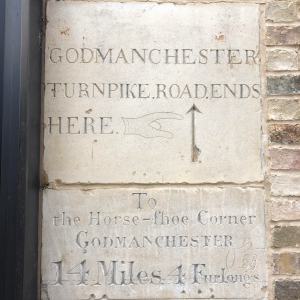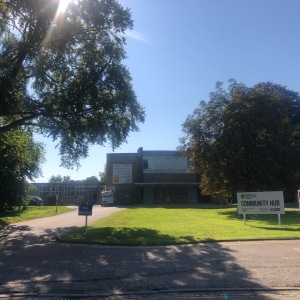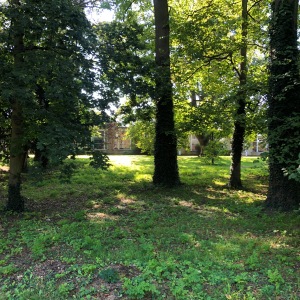On the trail of Nan and Betty: a visit to Cambridge
Posted: September 12, 2020 | Author: natalierosebradbury | Filed under: post-war | Tags: art, art education, art teaching, artists, Cambridge, Cambridge Society of Painters and Sculptors, Cambridgeshire, collections, Education, Elisabeth Vellacott, exhibitions, Galleries, Henry Morris, Impington, Impington Village College, Jim Ede, Kettle's Yard, loan collections, Local Education Authority, painting, Pictures for Schools, Sawston, Sawston Village College, sculpture, teacher training, teaching, University of Cambridge, village colleges | 1 Comment One of the things I’ve missed during this strange time has been the ability to visit and explore different cities. At the start of September I decided to squeeze in a mini-break in Cambridge.
One of the things I’ve missed during this strange time has been the ability to visit and explore different cities. At the start of September I decided to squeeze in a mini-break in Cambridge.
In many ways, Cambridgeshire was the epicentre of my PhD research (it’s where Nan Youngman lived and worked for most of her adult life, from the Second World War, until her death in 1995), yet I didn’t visit during my PhD.
Primarily, this is because Youngman’s papers were held between the Tate Archive and the University of Reading special collections, yet I decided to visit a few key sites relating to her life and career.
Paper Mills (now turned into flats), which is situated next to a leper chapel on Newmarket Road, is a picturesque early-eighteenth century paper mill conversion where Nan Youngman and Betty Rea set up home in the 1940s after the school in which Youngman taught was evacuated to Huntingdon. After a period in nearby Godmanchester, they rented Paper Mills until Betty’s untimely death in 1965 and it was a social hive for visiting artists, writers and intellectuals from across East Anglia. As well as artworks hung on the walls, Rea and Youngman collaborated on a mural with another Cambridge artist, Elisabeth Vellacott. Fom Paper Mills, Youngman ran art classes for local teachers and became involved in the Cambridge Society of Painters and Sculptors.


 Like Nan, Betty was committed to the social power of art and education and was also active in education and art in Cambridge. She taught at Homerton Teacher Training College (now the Institute of Education at the University of Cambridge) and some of her work is on display at Homerton. I intended to go to Homerton to see if I could see any of Betty’s sculptures but didn’t have time. I did see her sculpture the Swimmers, commissioned for Parkside Pools (the current pool is a modern replacement) – finished posthumously by Youngman and Rea’s close friend John W Mills in 1966. Situated in a shady spot on the edge of Donkey Common, rather than depicting the physical act of swimming the sculpture instead captures a social moment, a group of youngsters stopped for a chat; I’d love to know what they were talking about.
Like Nan, Betty was committed to the social power of art and education and was also active in education and art in Cambridge. She taught at Homerton Teacher Training College (now the Institute of Education at the University of Cambridge) and some of her work is on display at Homerton. I intended to go to Homerton to see if I could see any of Betty’s sculptures but didn’t have time. I did see her sculpture the Swimmers, commissioned for Parkside Pools (the current pool is a modern replacement) – finished posthumously by Youngman and Rea’s close friend John W Mills in 1966. Situated in a shady spot on the edge of Donkey Common, rather than depicting the physical act of swimming the sculpture instead captures a social moment, a group of youngsters stopped for a chat; I’d love to know what they were talking about.
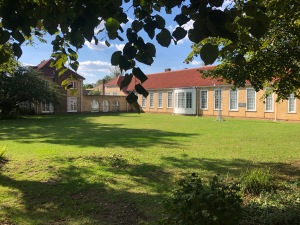



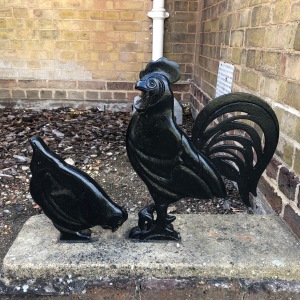 I also took some buses out to villages in the countryside outside Cambridgeshire to see two of the village colleges established by Cambridgeshire’s Director of Education from 1922-1954, Henry Morris. Conceived to combat a perceived rural decline, Morris embraced education that was lifelong, practical and vocational as well as academic and aimed to bring the community together around education, seeing these colleges as providing focal points and facilities for their local community. In 1944, Youngman made a speculative approach to Morris offering to be his part-time art adviser, and spent the next decade travelling around schools such as these aiming to improve teachers’ confidence in teaching art. Morris was a keen believer in the importance of art in schools, and the potential for well-designed environments (including works of art) to have a beneficial impact on children’s education. He supported Nan Youngman in organising an exhibition of contemporary art at Homerton College for teachers in Cambridgeshire in 1945; the Cambridgeshire Collection of Original Artworks for Children, initiated by Morris and Youngman, became one of the largest and most impressive and long-running school loan collections in the country (it was finally auctioned in 2017).
I also took some buses out to villages in the countryside outside Cambridgeshire to see two of the village colleges established by Cambridgeshire’s Director of Education from 1922-1954, Henry Morris. Conceived to combat a perceived rural decline, Morris embraced education that was lifelong, practical and vocational as well as academic and aimed to bring the community together around education, seeing these colleges as providing focal points and facilities for their local community. In 1944, Youngman made a speculative approach to Morris offering to be his part-time art adviser, and spent the next decade travelling around schools such as these aiming to improve teachers’ confidence in teaching art. Morris was a keen believer in the importance of art in schools, and the potential for well-designed environments (including works of art) to have a beneficial impact on children’s education. He supported Nan Youngman in organising an exhibition of contemporary art at Homerton College for teachers in Cambridgeshire in 1945; the Cambridgeshire Collection of Original Artworks for Children, initiated by Morris and Youngman, became one of the largest and most impressive and long-running school loan collections in the country (it was finally auctioned in 2017).
At colleges such as Sawston (opened in 1930) and the Fry and Gropius-designed Impington (opened in 1939) she engaged children in collaborative projects such as creating murals based on their lives and their experiences of the local area.
Finally, I fulfilled a long-held ambition to visit the contemporary art gallery Kettle’s Yard (where Youngman had a retrospective in 1987), which was established in the home of curator and collector Jim Ede in 1957 and converted from a series of formerly run-down cottages. Ede wanted Kettle’s Yard to be a place of conviviality and socialising – a meeting place, where relationships were formed, culture was experienced and discussed. He believed that young people – students in this case – should be exposed to contemporary art. He invited students from Cambridge University to his home for tea and to see and discuss the artworks from his collection and later initiated a scheme to lend artworks for their rooms (students from Cambridge and Anglia Ruskin Universities continue to be able to borrow artworks from his collection to this day).




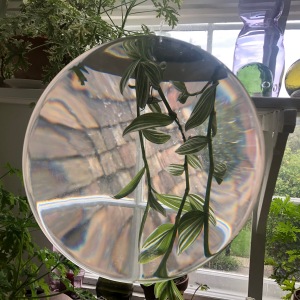


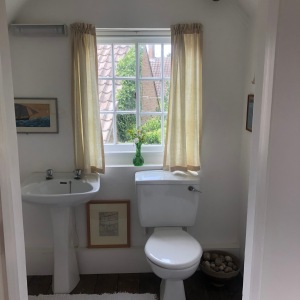 Today, Ede’s home is maintained as a museum, with his artworks displayed in a domestic setting alongside collections of found objects such as pebbles, and carefully arranged plants. Whilst very well-known British and international artists are represented in the collection, from Ben Nicholson and Alfred Wallis to Joan Miro, perhaps my favourite work – set off by its setting next to stacks of plants situated in front of a light-filled window – was Bare Trees and Hills (circa 1960), a delicate pencil drawing by Youngman and Rea’s friend and contemporary Elisabeth Vellacott – an artist whose name I have seen often before, but whose work I had only ever from a distance online or in books.
Today, Ede’s home is maintained as a museum, with his artworks displayed in a domestic setting alongside collections of found objects such as pebbles, and carefully arranged plants. Whilst very well-known British and international artists are represented in the collection, from Ben Nicholson and Alfred Wallis to Joan Miro, perhaps my favourite work – set off by its setting next to stacks of plants situated in front of a light-filled window – was Bare Trees and Hills (circa 1960), a delicate pencil drawing by Youngman and Rea’s friend and contemporary Elisabeth Vellacott – an artist whose name I have seen often before, but whose work I had only ever from a distance online or in books.

